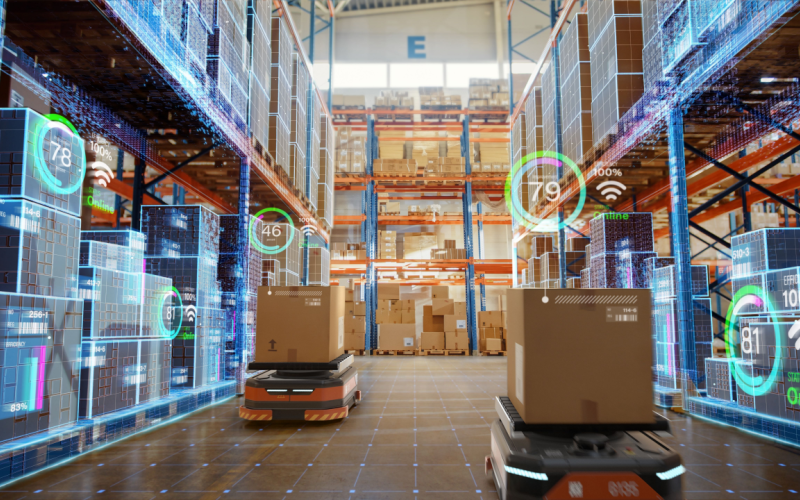Supply chain issues as a topic of dinner conversation? It’s probably not what anyone would have suspected just a few years ago. But over the last few years, stories of supply chain shortages and delays have become part of nightly news and national media outlets. Stock outs, missed orders, long lead-times, and uncertainty have made the supply chain a hot topic, especially with the holiday season upon us, and the need to make improvements have become a C-level priority.
For the warehouse, supply chain improvements revolve around being productive, meeting customer service levels, effectively managing inventory, and running an optimal warehouse. All the recent disruptions in the supply chain have created an environment that accelerates innovation, digital transformation and enhanced automation.
Automation in the warehouse is nothing new. Conveyors, automated storage and retrieval systems, sorters and many other technologies have been in use by distribution centers for decades. As new technologies have become available, operations leaders have adopted them to achieve heightened customer service levels, offsetting labor shortages and improving order accuracy.
Robotics and Automation on the Rise
According to their 2022 MHI Annual industry report, robotics and automation adoption is projected to more than double over the next five years. Recent supply chain disruptions, labor shortages and the rapid transformation of consumer buying behavior driving toward e-commerce is contributing to this trend. Distribution centers are innovating to meet the evolving needs of their business. This goes beyond traditional, fixed equipment to mobile robots such as automated guided vehicles (AGV) and autonomous mobile robots (AMR).
With Many Robots Come New Complexities
Robots can deliver significant benefits to warehouses. Whether it is acting as a picking assistant, bringing goods to a person for picking, packing, or building, moving pallets, robots offer a viable solution in the face of increasing order volume and labor uncertainty. With the variety of robots available to the warehouse, leveraging multiple vendors’ technology may be the optimal choice. These robots will need work together seamlessly. The successful onboarding of the robots from multiple vendors becomes an important success factor.
A single communication point can make the onboarding process more streamlined and improve the ability of the robots to work in concert with one another, as well as their human counterparts.
Edge Technology Gaining Importance
The Internet of Things (IoT) has created a consumer technology revolution. From smart homes to smart cars to smart phones, visibility and control of devices are at your fingertips. Vacationers who may be nervous leaving their home for fear of a water-break or other occurrence can now install IoT enabled sensors to alert them. Inexpensive, IoT webcams that leverage advanced sensor technology can help remotely monitor anything going on at home.
With more and more business technology moving to the cloud, industrial Internet of Things (IIoT) creates new opportunities to leverage more robust sensors and other technologies to streamline business operations without adding additional cost and labor.
Building the Warehouse of the Future
Many operations have already started their digital transformation journey to create their own warehouse of the future. By combining robotics, edge technologies and other intelligence, the distribution center becomes more efficient. Controlling and orchestrating not only the movement of goods and resources in the warehouse, but information flow across a central intelligence platform using artificial intelligence (AI) and machine learning (ML) to help operators improve service, see issues in advance and adapt to the complexity of their new supply chain.
In our warehouse of the future video, we explore the movement of goods from the yard, through receiving and putaway, to picking and packing and shipping.
Streamlining the Flow of Goods and Movement of Resources
Automation and humans can be orchestrated to deliver the most efficient movement of goods through the supply chain. With visibility to incoming and outgoing loads, work can be planned and orchestrated. Edge technologies can identify and check in trailers. Robots or humans on forklifts can unload the trailer and stage pallets for storage. AGVs, AMRs and other robots work in concert with their forklift counterparts and automated storage systems to move pallets and cases to storage based on order and rotation requirements.
Blue Yonder’s solutions can do all of this to ensure accurate, real-time location and inventory availability.
At shipping, Blue Yonder’s Warehouse Management Solution, in concert with Warehouse Tasking and Robotics Hub sorts and prioritizes orders and creates and distributes tasks for automation and humans to work on together to move products to packing or staging stations. Blue Yonder manages order status throughput the process. Intelligent routing and load building in Blue Yonder’s Transportation Management creates the optimal loads and shipping routes. Based on the load plan, packages move on conveyors or forklift drivers are directed to the correct door for trailer or parcel loading. As the trailer departs, it is checked out. Blue Yonder’s solutions ensure the right products arrive at the right locations on-time and at the lowest cost.
Enabling the Warehouse of the Future
With Blue Yonder the automated warehouse goes to the next level. By optimizing storage and selection strategies, orchestrating work between automation and humans, and creating efficient outbound loads, Blue Yonder’s suite of supply chain solutions lower costs, improve efficiency and align with corporate sustainability goals.
Learn more about Blue Yonder’s supply chain execution solutions.

